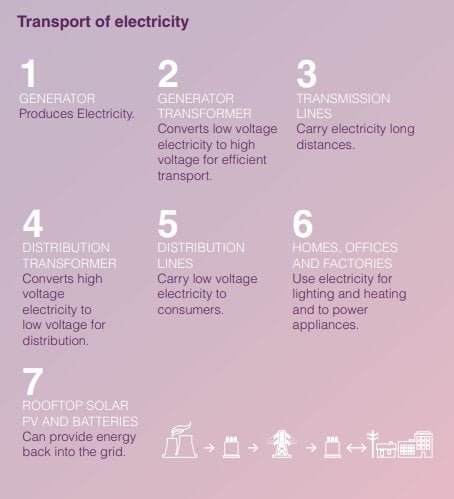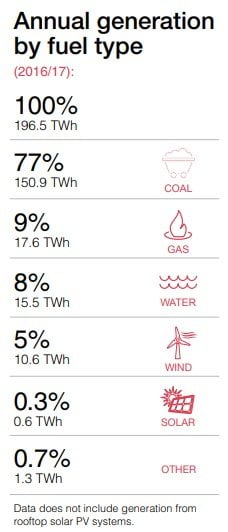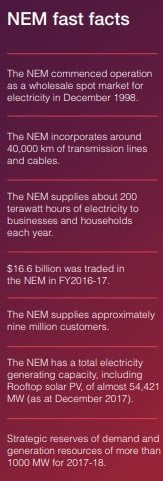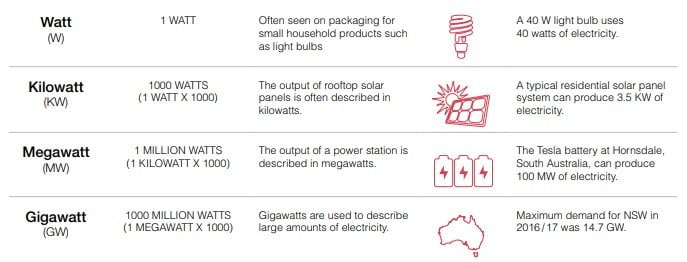To understand how electricity is bought and sold on Australia’s complex National Energy Market, we must first look at the different stages of generation, distribution and, finally, consumption.
Electricity begins its journey to your business premises at one of the many power stations around the country where it is generated. Power stations, or generators, burn fossil fuels or make use of wind, solar or hydro to create power.

Battery technology is still in its infancy, so by and large, all power generated is according to immediate needs.
When it is created, it is then transported over vast distances through high voltage lines by distribution networks.
Because Australia is a massive country and is sparsely populated, it has one of the longest alternating current systems in the world.
Electricity is transformed to lower voltages at substations before being distributed to homes and businesses which is sold by the retailers.
So how do all these players tie in together to make up the National Energy Market? Here’s a cheat sheet to help you understand the process.
Generators
Power stations burn coal, shale or gas to produce electricity. Green generators use the power of the wind, the sun and pumped hydro to produce electricity.

Pumped hydro is technically considered to be battery storage.
Generators send the energy they create into the grid, selling the power they produce on the National Energy Market.
Distributors & Networks
Distributors own and maintain the networks which include power lines and electricity poles.
They are normally referred to as ‘poles and wires’. Distributors are held responsible for interruptions and faults caused by events such as fallen power lines or sheared electricity cables.
The role of distributors is to transport electricity from generators to the end user.
Retailers
Retailers buy electricity at a wholesale price from the National Energy Market. It then sells it on to retail customers such as homes, small and medium-sized businesses and corporate clients. Retailers are responsible for connecting customers to the network, billing and customer service.
The National Energy Market

The National Energy Market is a wholesale market where energy generated in Australia is bought and sold, which is regulated by the Australian Energy Market Operator (AEMO). Because the NEM is subject to the same demand and supply factors as any other liberalised market and prices fluctuate as a result.
If demand is high, for example in summer when air conditioning units are cranked up, then prices will likely be driven up. If demand is low, for example on a warm winter’s day, then prices are likely to go down.
Because it is a competitive market, generators compete with each other to sell produced electricity at the best price. Retailers then purchase that energy and theoretically, those savings should be passed on to the consumer.
The electricity grid transports electricity, but it cannot store it. Battery storage is a very modern phenomenon and as a result, demand needs to be monitored in real time. When a heatwave hits the country, it places a huge strain on the grid as demand for power can often outstrips supply.
AEMO is responsible for managing the energy dispatch system, to ensure that there is enough power in the grid to keep the lights on. Battery storage in South Australia has been a game changer in this regard and the Tesla factory recently pushed power out within 0.14 seconds of a power station trip in Victoria on a hot day, preventing the grid from tripping.
AEMO has said that battery storage is very much part of its plans and will play a bigger role in dispatching emergency power into the grid in the future. The reason for this is that if demand is higher than supply, it takes gas and coal turbines up to 20 minutes to get up to speed if emergency power is needed. Batteries, on the other hand, release power immediately.
The purchasing process in the National Energy Market
So how does the pricing part work? Electricity generators send their bids to AEMO on a daily basis, outlining how much electricity they plan to supply and at what price. AEMO’s role is to then match the generation bids with predicted demand from the retail price. This is known as the Dispatch Process and it calculates the most effective and lowest cost generation mix.
That process creates what is known as a Spot Price. The wholesale market settles when generators receive the spot price for the energy they supply, and in turn, retailers must settle up for the spot prices they have paid for power to supply their customers with.
The wholesale market is settled when generators receive the spot price for the electricity they supply and retailers pay the spot price for the electricity they buy for their customers. The National Energy Market infrastructure is made up of both state and privately-owned companies and assets.
How is electricity measured?
The chart below can provide a more concrete idea of how electricity is measured and used.

Want to save on your commercial electricity consumption?
We hope our article on the National Energy Market gives you some insight on how electricity is traded in Australia. Now if you want to save on your business’ energy consumption our Energy Experts, who are always keeping watch on the NEM, can let you know the best time to sign up for a new contract.
To learn more about how Leading Edge Energy can help you get better rates for your energy use, you may read about our services, call us at 1300 852 770, or e-mail us at hello@leadingedgeenergy.com.au. Our Energy Experts are more than happy to get you started on your journey to energy efficiency.












